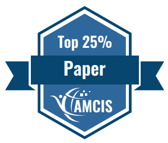Systems Analysis and Design (SIG SAND)
Loading...
Paper Type
Complete
Paper Number
1128
Description
The goal of this paper is to establish the notion of "technology-specific modeling method" instantiated by a showcase example that was realized as a Design Science artifact, within the Agile Modeling Method Engineering framework, considering a particular technological context and technology-dependent purpose – the management of ETL (extract-transform-load) processes and their interoperability with an in-house ETL platform running in an organization that deals with heavy data management and orchestration tasks. With the term "technology-specific", we refer to a level of specificity that does not stem from concepts pertaining to the business sector or goals, but from technological abstractions already available in the model-driven environment where models are intended to be used. Besides reporting on the engineering details of a showcase modeling language, the paper also draws theoretical reflections on the notion of "technology-specific modeling" and what distinguishes it from the traditional domain-specific class of modeling languages.
Recommended Citation
Deme, Andrea and Buchmann, Robert, "A Technology-Specific Modeling Method for Data ETL Processes" (2021). AMCIS 2021 Proceedings. 2.
https://aisel.aisnet.org/amcis2021/sig_sand/sig_sand/2
A Technology-Specific Modeling Method for Data ETL Processes
The goal of this paper is to establish the notion of "technology-specific modeling method" instantiated by a showcase example that was realized as a Design Science artifact, within the Agile Modeling Method Engineering framework, considering a particular technological context and technology-dependent purpose – the management of ETL (extract-transform-load) processes and their interoperability with an in-house ETL platform running in an organization that deals with heavy data management and orchestration tasks. With the term "technology-specific", we refer to a level of specificity that does not stem from concepts pertaining to the business sector or goals, but from technological abstractions already available in the model-driven environment where models are intended to be used. Besides reporting on the engineering details of a showcase modeling language, the paper also draws theoretical reflections on the notion of "technology-specific modeling" and what distinguishes it from the traditional domain-specific class of modeling languages.
When commenting on articles, please be friendly, welcoming, respectful and abide by the AIS eLibrary Discussion Thread Code of Conduct posted here.



